
~~~~~~~~~~~~~~~~~~~~~~~~~~~~~~~~~~~~~~~~~~~
Live Earth Farm (Com)Post
7th Harvest Week, Season 13
May 19th - 25th, 2008
~~~~~~~~~~~~~~~~~~~~~~~~~~~~~~~~~~~~~~~~~~~
In this issue
--Greetings from Farmer Tom
--What's Up in the Field
--Live Earth Farm Kids
--Mmmm bread!
--Too much food?
--Alert: Raw Favas Not for Everyone...
--Pictures around the farm
--What's in the box this week
--Notes from Debbie's Kitchen
--Calendar of Events
--Contact Information
" All human beings have in common the desire to avoid
suffering and to achieve happiness. "
~ Dalai Lama
Greetings from Farmer Tom
~~~~~~~~~~~~~~~~~~~~~~~~~~~~~~~~~~~~~~~~~~~~~~~~
Last week was, no question, one of the hottest I've ever experienced. Heat waves always make me nervous, but the nervousness has more to do with timing than the degree to which the heat will rise. The brunt of the hot weather came on Thursday and Friday, which was fortuitous for us since the busiest harvest and packing days are on Tuesday and Wednesday. I remember from my running days how important it is to start a race well hydrated, and most importantly stay hydrated during the run. Monday through Wednesday we pre-irrigated the fields, which helped reduce crop damage during the hottest periods on Thursday and Friday. Even though the most sensitive plants got watered both morning and evening, some of our berries, leafy greens, and freshly transplanted broccoli just weren't prepared to switch from cool and foggy to hot and dry on such short notice.
Heat is not only stressful to plants, but also to the team of people working outside in the fields. Even under normal conditions it is physically strenuous to accomplish the many tasks necessary to grow, harvest, pack and deliver our weekly shares.
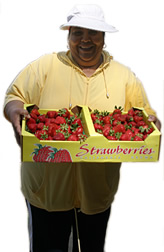 It
is remarkable, and I am proud to work side-by-side with such an incredible team
of workers who, regardless of what the weather throws at them – hot,
cold, or wet – or regardless of mechanical setbacks such as broken water
pumps, or tractors stuck in the field with a flat tire... there is harmony and
good will among them. On Friday morning when the temperature was already well
above 80 degrees, Juan’s wife Angeles, visibly hot, carrying a full flat
of strawberries out of her row, smiles and says, "Oye como da ganas! Aunque
caliente, esta ya es mi quarta y todavia me falta." (It's hot but
I enjoy this. Look, this is my forth [flat] and I still have some left to pick!) I
am reminded of Rudolph Steiner who describes the energetic qualities that exist
on a farm and how important it is to treat a farm as a living organism. The individuality
and character of such a farm organism finds its expression through the human
element. I attribute much of Live Earth Farm's character and individuality to
the positive and committed interaction our workers have with each other and with
the soil which grows our food.
It
is remarkable, and I am proud to work side-by-side with such an incredible team
of workers who, regardless of what the weather throws at them – hot,
cold, or wet – or regardless of mechanical setbacks such as broken water
pumps, or tractors stuck in the field with a flat tire... there is harmony and
good will among them. On Friday morning when the temperature was already well
above 80 degrees, Juan’s wife Angeles, visibly hot, carrying a full flat
of strawberries out of her row, smiles and says, "Oye como da ganas! Aunque
caliente, esta ya es mi quarta y todavia me falta." (It's hot but
I enjoy this. Look, this is my forth [flat] and I still have some left to pick!) I
am reminded of Rudolph Steiner who describes the energetic qualities that exist
on a farm and how important it is to treat a farm as a living organism. The individuality
and character of such a farm organism finds its expression through the human
element. I attribute much of Live Earth Farm's character and individuality to
the positive and committed interaction our workers have with each other and with
the soil which grows our food. Back to the heat! On Thursday at noon when the thermometer hit 95 "in the shade" everybody except a few of us in charge of watering got the rest of the day off. Friday we got up at the crack of dawn to beat the heat. First we harvested for the weekend markets, then the pressure was on to rescue the squash, cucumbers, carrots and tomatoes from an onslaught of weeds. Weeds thrive with water and heat, growing almost exponentially. Timing is everything when it comes to weeding: not only does properly timed weeding save hundreds of future hours of tedious hand weeding, but more importantly, the hours saved can be more productively spend on something else. On Friday we only had a small window of opportunity to weed before it got too hot again and more water was needed to keep our thirsty plants alive. Waiting until Monday to weed was not an option. The weeds would have engulfed everything we planted. The highest priority was the small and slow growing crop of carrots; if we couldn’t weed them until Monday it would leave me no choice other than to plow them under and sow again.
In summary, we survived this first heat wave well, so some of your greens appear a bit sun-damaged or you see a strawberry with some discoloration, think of the sun-loving crops to come... the tomatoes, apricots and peppers which got a nice boost and loved this welcome change in weather. Go figure; it never fails. Gain some lose some.
- Tom
<back to top>
What's Up in the Field
~~~~~~~~~~~~~~~~~~~~~~~~~~~~~~~~~~~~~~~~~~~~~~~~
This will probably be the last week you will receive fava beans. Next week we
hope to have spinach in the shares, more carrots (hopefully for everyone), mustard
greens, fennel, and more radishes... In the pipeline for the not too distant
future: Napa cabbage, radicchio, summer squash, dill, and of course potatoes!
<back to top>
Live Earth Farm Kids
~~~~~~~~~~~~~~~~~~~~~~~~~~~~~~~~~~~~~~~~~~~~~~~~

From member Nathan Jewell, "Here is a pic of my youngest, Jesse Jewell, trying
beets for the first time. He loved them! And we love getting our gorgeous box
of veggies every week, thank you so much!"
And a great quote from member Sarah Laurie, “My kids are absolutely addicted
to the strawberries from the farm. My toddler only says about 20 words, and BERRIES!
is one of them. Thanks again!”
<back to top>
Mmmm bread!
~~~~~~~~~~~~~~~~~~~~~~~~~~~~~~~~~~~~~~~~~~~~~~~~
Got this comment from a member last week:
“I just have to tell you and the other members that the bread was absolutely
DELICIOUS! I am so excited I signed up for the share. Please pass
along my thanks and gratitude to the baker. It was Scrumptuous. Everyone
needs to taste this loaf of heaven!”
[signed] one happy member,
Brandee T.
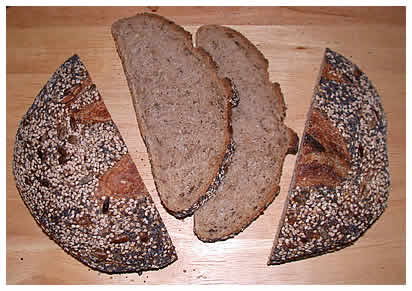
(pictured above is Companion Baker's 3-seed whole wheat)
Debbie adding my two cents: I, too, am really enjoying the bread, not only for
its great sourdough flavor and sturdy texture (I don’t like flabby, soft,
preservative-filled bread), but also for the integrity of the baker and the ingredients
she puts into her labors. Worried that preservative-free
bread doesn’t
last that long? Here’s what I do all the time: I pre-slice my loaf and
then freeze it in a plastic bag. Then it is easy as pie to pull out slices as
needed, and then toast to your favorite degree of done-ness... for toast for
breakfast, or just warmed through with the slightest hint of crunchiness for
a nice sandwich! It is just as fresh as if you'd sliced it the day you got it
home!
Baker Erin Justus has just announced that she has signed a lease for a new home
for Companion Bakers (instead of renting kitchen space), and will be building
her long-desired wood-fired oven for her breads, so this is exciting news! She
will give me something to put in the newsletter when the time is right.
Again, if you are interested in adding a bread option to your share, they are
still available! The cost is $6/week and the bread option runs the length of
the season. Contact Debbie at the farm and she can set you up!
<back to top>
Too much food?
~~~~~~~~~~~~~~~~~~~~~~~~~~~~~~~~~~~~~~~~~~~~~~~~
It invariably happens that we have a few people drop out because, even though
they’re getting a Small Share, they can’t use it all and don’t
like to see all their beautiful food go to waste. If you see yourself on the
cusp of this problem, but are loathe to cancel out on the whole program, I have
a suggestion: consider donating your share every so often. Or maybe just once,
if there’s a week where you really fall behind. Donating is easy to do,
someone else will make good use of the food, and you can relax and use up what
you already have in your fridge, and then be eagerly anticipating the following
week’s box instead of anxious about what you’re going to do with
it all! :-)
How to donate? Just email Debbie at the farm at least 48 hrs before delivery
day, and put ‘donate my share’ in the subject line (so I’ll
spot it quickly), then tell me who you are and what day you want to donate your
share and I’ll take care of it. Right now, donated shares are taken over
to Loaves and Fishes in Watsonville, where the food is distributed to hungry
families. We have two wonderful members, Tera Martin and Ellen Kureshi, who take
turns shuttling donated shares from the farm to Loaves and Fishes. Many thanks
Tera and Ellen!!
<back to top>
Alert: Raw Favas not for everyone...
~~~~~~~~~~~~~~~~~~~~~~~~~~~~~~~~~~~~~~~~~~~~~~~~
Member Alicia Woodrow emailed me [Debbie] with a warning about eating raw fava
beans.
“They can cause immediate and severe reaction, and sometimes be fatal to
some people who have a certain genetic predisposition,” she says. Here
is the reference in Wikipedia:
http://en.wikipedia.org/wiki/Vicia_faba#Health_issues
The same can be said for peanuts, of course; there are definitely folks out there
for whom eating peanuts can also be fatal. So if you are at all concerned,
please don’t eat raw favas. Tom says, “Although many people do eat
them uncooked, this may be the least recommended form for ingesting fava beans.
Fava beans are generally a common dietary food item in many cultures throughout
the world, however it is important to be aware of the inherent risk.”
So if you decide you want to try
them raw, do so with caution; maybe nibble one first, then wait 24 hours (that's
how I tried them my first time, actually). I have eaten them raw a couple times
now without reaction, and Tom says he has too, and that Italians even have a
festival/seasonal tradition where they gather in the fields and harvest and eat
raw favas and drink wine and eat cheese and make merry.
Again, if you’re at all concerned, be sure you cook them. For more information,
look up ‘Favism’ online and read about it. Here is another source
of information, from the ARC
Centre of Excellence for Integrated Legume Research. The key wording from
this source on the topic is as follows:
"Fava beans can cause problems for a small percentage of people. Favism is an
inherited condition in which a person lacks an enzyme called glucose-6-phosphate
dehydrogenase (G6PD). This rare deficiency occurs mostly among people of Mediterranean,
African, and Southeast Asian descent. The condition helps serve as a defence
against malaria by reducing the amount of oxygen in red blood cells. However,
for people with favism, eating undercooked fava beans or breathing fava bean
pollen can lead to a serious anaemic condition. Fava beans are also higher than
most beans in complex carbohydrates called oligosaccharides, which may cause
gas and abdominal pains."
<back to top>
Pictures around the farm
~~~~~~~~~~~~~~~~~~~~~~~~~~~~~~~~~~~~~~~~~~~~~~~~
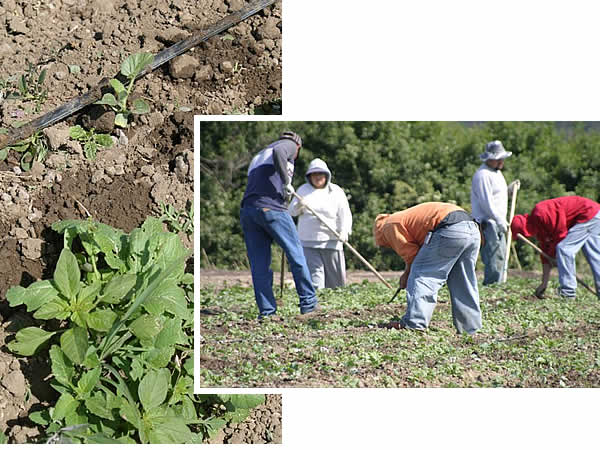
Manual weeding is done around the crops in the rows (see small cucumber
plant next to drip tape), however the (much more prolific) weeds in
between the rows are left for the tractor to take out.
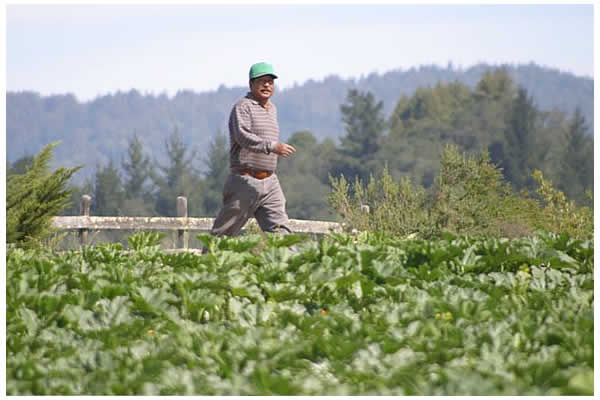
A man outstanding in his field: Tom's right-hand man, Juan, heading back from
the 'upper 40.'
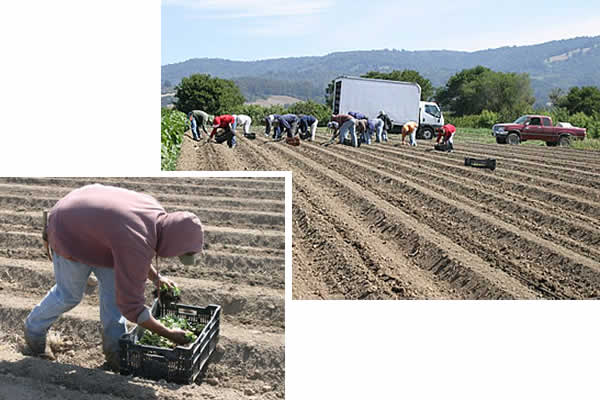
Everyone out planting basil!
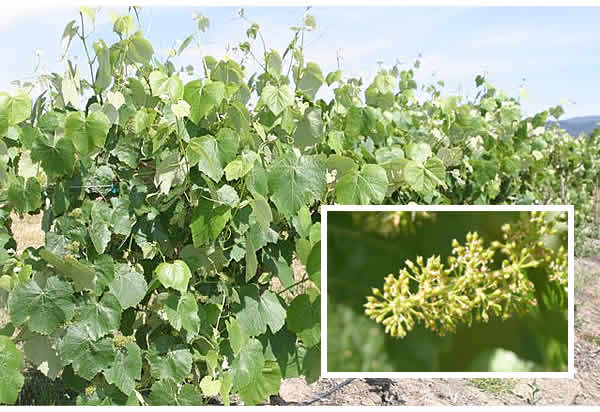
Our concord grape vines... if all goes well, we should have a bumper crop
this year!
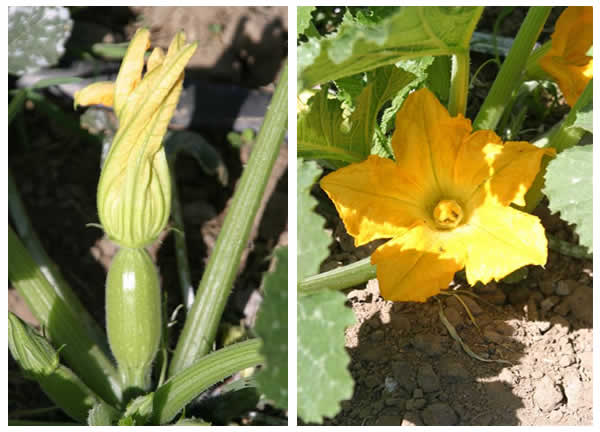
Summer squash will be coming soon, especially if the days continue to
be warm!
What's in the box this week
~~~~~~~~~~~~~~~~~~~~~~~~~~~~~~~~~~~~~~~~~~~~~~~~
Content differences between Family and Small
Shares are in red; items
with a “+” in
Family Shares are more in quantity than in Small; anticipated quantities, if
any, are in parentheses, as are the source of any produce if not from Live Earth
Farm (LEF). Occasionally content will differ
from this list (typically we will make a substitution), but we do our best to
give you an accurate projection.
Family Share:
Arugula +
Broccolini or broccoli + (if broccoli, from Lakeside)
Carrots
Chard
Collard greens
Fava beans +
Green garlic (getting more mature though!)
Lettuce +
Onions +
French breakfast radishes +
Strawberries (should be 3 baskets; go by list in binder for final qty)
Small Share:
Arugula
Broccolini or broccoli (if broccoli, from Lakeside)
Chard
Fava beans
Green garlic (getting more mature though!)
Lettuce
Onions
French breakfast radishes
Strawberries (may also be 3 baskets; go by list in binder for final qty)
Extra Fruit Option:
3 baskets of strawberries
Fruit "Bounty" Option, week 2:
3 baskets of strawberries
[Note: last week’s *Thursday* members did not get their “bounty” (Debbie’s
error; mea culpa!!)! You will get it this week, which means Thursday’s “bounty” members
will get 6 baskets!]
<back to top>
Notes from Debbie's Kitchen
~~~~~~~~~~~~~~~~~~~~~~~~~~~~~~~~~~~~~~~~~~~~~~~~
Click
here to go to recipe database
Last week upon the first appearance of collard greens (in
the Small share; this week they’re in the Family share – next week, they’ll
probably be in both!), two different members emailed me with some excellent information
about them. I’d never known this before myself, and so am anxious to try
this when I get them:
Marina Peregrino says, “the trick to collard greens is to slice them thinly.
layer them and roll them up like a big cigar and then slice them as thinly as
you can, this way they cook quickly and are tender and delicious. Some people
go really crazy and roll then extra tightly wrap it in rubber bands and slice
with a razor blade – really!”
And Farrell Podgorsek says, “The collard greens make a nice crunchy slaw
when very finely shredded or sliced. Combine any veggies desired - radish, carrots,
finely shredded or grated onion, fresh herbs, etc, mix in a vinaigrette dressing
and let sit in the refrigerator for a couple of hours. Be sure the dressing has
salt it in to help break down the greens.”
Meanwhile regarding green garlic, Farrel says, “Also, we have been
poaching the green garlic in a few dishes and love the texture and flavor. Simply
trim down the stalk, put in boiling water for 1-2 minutes, then remove and minced
or slice for your recipe. We combined poached garlic with blanched kale,
lemon juice, salt and pepper and a drizzle of olive oil - it was almost creamy
in texture.”
And here’s a recipe from an article on green garlic
sent to me by member Celesta Birnbaum:
Green Garlic Dip
modified from a recipe in a NYTimes
article written by Jeff Patterson, chef/owner
of Coi in San Francisco. Suggested as a dip for artichokes (yummm!), but could
also be used wherever you might use an aioli.
3⁄4 C minced green garlic, white and light green parts only
1 egg
2 tsp. sherry vinegar
1 tbsp. plus 1 teaspoon red-wine vinegar
6 tbsp. fruity extra virgin olive oil
1⁄2 C pure olive oil
Salt
In a small saucepan, bring 1⁄4 cup of water and the green garlic to a gentle
simmer, cover and cook until tender, about 5 minutes. Strain the garlic, and
let cool.
In a blender, purée the egg, vinegars and cooled green garlic on medium-high.
With the blender running, add the oils in a slow, steady stream to emulsify.
Season with salt.
Since this will be the last of the favas, here’s one
last fava recipe! This was sent to me by member Beth Erskine.
Fava Bean “Pesto”
From the Earthbound Farm Organic Cookbook “Food to Live By” by
Myra Goodman.
Makes about 1 cup.
Good tossed with pasta or spread on toasted baguette slices.
1 C shelled fresh fava beans (from 1 lb. of pods)
2 small cloves garlic [check your green garlics; cloves may be starting to take
shape! if not yet, just mince up a goodly amount of green garlic]
1 tbsp. fresh lemon juice
About ½ C extra virgin olive oil
½ C freshly grated Parmesan or Pecorino Romano cheese
½ tsp. salt
¼ tsp. freshly ground black pepper
1. Fill a large bowl of water with ice cubes and set aside.
2. Bring a large pot of salted water to a boil over high heat. Add the
fava beans and cook until the skins loosen, about 1 minute. Immediately
drain the beans in a colander, then plunge them into the bowl of ice water to
stop the cooking. Drain the beans again in the colander.
3. When the fava beans are cool enough to handle, peel them by pinching a small
hole in the tough outside skin of a bean with your fingernail. Gently squeeze
the bean to release the 2 tender inner bean halves. Repeat with the remaining
beans.
4. Place the fava beans and garlic in a blender or food processor and pulse until
coarsely pureed. Add the lemon juice and 1/3 cup of the olive oil and puree
until smooth, stopping to scrape the side of the bowl, as necessary.
5. Add the Parmesan cheese, salt and pepper. Process briefly to combine. If
the mixture seems too dry, add the remaining olive oil and process to blend. The “pesto” can
be kept at room temperature for up to 4 hours, or refrigerated, covered, for
up to five days.
Here’s a chard recipe I’ve been saving
to share with you all for awhile now:
Ricotta – Swiss Chard Gnocchi
from an undated clipping from the magazine La Cucina Italiana
serves 6
“Called Ignudi or Gnudoni, these are basically ‘nude’ ravioli,
hence their name.”
For the gnocchi:
1 lb. 2 oz. Swiss chard leaves [I wouldn’t worry about exactitude;
just note mostly that the proportion of chard to ricotta is 50:50]
1 lb. 2 oz. fresh ricotta
2 eggs
1 C freshly grated Parmigiano Reggiano
2 tbsp. potato starch [or equivalent]
2 tbsp. flour, plus extra
1/8th tsp. freshly grated nutmeg
For the sauce:
1 stick unsalted butter
3 sge leaves
1 C freshly grated Parmigiano Reggiano
Make the gnocchi: Cook the chard for 10 minutes in a pot with 1 C of boiling
salted water. Drain, cool, then squeeze chard to get rid of excess water; chop
finely. In a large mixing bowl, combine the chard, ricotta, eggs, Parmigiano,
potato starch, flour and nutmeg. Once a dough has formed, snip off walnut-sized
pieces of it and shape into 1” patties with your hands; dust with flour
and spread out on a floured baking sheet, being careful not to pile the gnocchi
as you do so or they will stick together. [Debbie’s tip: gnocchi freeze
well; if you do this step and put a sheet of waxed paper on your baking sheet
under the gnocchi, then stick them into the freezer. When the gnocchi are frozen
solid, remove them to a ziploc bag and store back in the freezer. Then decant
as many as you want to and cook normally, i.e. in boiling salted water, until
they float.]
Bring 4 qts. of water to a gentle boil, drop in the ghocchi, a few at a time,
and cook until they rise to the surface of the water; remove them to a warm bowl
with a slotted spoon as they rise to the surface.
Meanwhile, make the sauce: Melt the butter in a skillet with the sage leaves.
Arrange the gnocchi on 6 plates, and pour on the butter-sage sauce. Sprinkle
with Parmigiano, and serve immediately.
Braised carrots with saffron
from an undated SJ Mercury News clipping, attributed
to a cookbook called “A
Great American Cook” by Jonathan Waxman
serves 4 to 6
2 lbs. medium carrots
Sea salt
¼ C olive oil
A good pinch of saffron threads
2 tbsp. sherry vinegar
1 tbsp. unsalted butter
Freshly ground black pepper
Trim and peel the carrots if you like, but leave them whole. Place them in a
medium saucepan with 1 ½ C water and a little sea salt and bring to a
boil. Cover and boil gently over medium heat until the carrots are al dente,
about 15 minutes. Drain carrots and pat dry.
Heat olive oil in large skillet over medium-low heat. When it’s warm, add
carrots and cook gently for 3 minutes. Add saffron and sherry vinegar and cook
2 minutes, turning carrots once or twice. Add butter, cover skillet, and let
stand off heat for 5 minutes. Season with salt and pepper and serve.
And lastly... what the heck; now that we’re
getting lots of strawberries, here is a classic, from Julia Child no less!
The lead-in to the clipping says, “Fresh fruit tarts are easy to make,
pretty to look at and refreshing to eat. They consist of a fully baked tart shell
lined with liqueur-flavored custard filling; the fresh fruit is arranged over
the filling and topped with apricot or red currant glaze.”
Fresh strawberry tart
serves 8
Pastry shell:
1 1/3 C flour (scooped and leveled)
3 to 7 tbsp. granulated sugar
1/8 tsp double-action baking powder
7 tbsp. butter
1 egg beaten with 1 tsp. vanilla
Custard filling:
1 C granulated sugar
5 egg yolks
½ C flour (scooped and leveled)
2 C milk
1 tbsp. butter
2 or 3 tbsp. kirsch or cognac
Fruit and fruit glaze:
1 qt. large, ripe, handsome strawberries [we know where to get these!!]
1 C red currant jelly
2 tbsp. granulated sugar
2 tbsp. kirsch or cognac
Make pastry shell: Preheat oven to 375 degrees. Place flour, sugar, baking powder
and butter in a 3 qt. mixing bowl. Rub fat and dry ingredients together rapidly
with tips of fingers until fat is broken into bits the size of small oatmeal
flakes. Blend in egg and vanilla and knead dough rapidly into a ball. Place on
pastry board and, with the heel of your hand, rapidly press pastry by two-spoonful
bits down on the board and away from you in a firm, quick smear of about 6 inches.
Dough will be quite sticky if you have used the full amount of sugar. Form again
into a ball. Wrap in waxed paper and chill several hours until firm.
Mold pastry into a flan ring or false-bottomed cake pan [spring-form pan]. Use
foil, beans or a bean-filled mold to hold the sides in place. Bake in middle
level of oven for 5 to 6 minutes until dough is set. Then remove lining, prick
bottom of pastry with fork in several places and bake 8 to 10 minutes more. Shell
is done when it has shrunk slightly from mold and begins to brown very lightly.
Immediately remove mold from the shell and slip shell onto a rack. It will become
crusty as it cools.
Make the custard filling: Into a 3-qt. mixing bowl, use wire whip or electric
beater to gradually beat sugar into egg yolks. Continue beating 2 to 3 minutes
until mixture is pale yellow. [It may be a brighter yellow if you use Jim’s
eggs!] Beat in flour. Bring milk to boil. Beating yolk mixture, gradually pour
in a thin stream of droplets of boiling milk. Pour into heavy-bottomed, 2 ½ qt.
saucepan and set over moderately high heat. Stir with wire whip, reaching all
over bottom of pan. As sauce comes to boil it will get lumpy but will smooth
out as you beat it. When boil is reached, beat over moderately low heat for 2
to 3 minutes to cook flour. Be careful custard does not scorch in bottom of pan.
Remove from heat and beat in butter, then kirsch or cognac. Let cool.
Prepare fruit and glaze: Hull strawberries. If necessary to wash them, do so
very quickly, and drain on rack [I wouldn’t bother washing them.] Boil
currant jelly, sugar and liqueur in small saucepan until the last drops from
spoon are sticky (228 degrees). Paint interior shell with thin coating of glaze
and allow to set for 5 minutes. Reserve rest of glaze for the strawberries. Warm
it briefly if it has hardened.
To assemble tart: Spread 1/2 – inch layer of custard in the bottom of pastry
shell. Arrange a design of strawberries over the cream. Put largest strawberry
in center and graduate down in size, placing berries closely together, stem ends
in the cream. Spoon or paint over them a thin coating of the glaze, and tart
is ready to serve.
<back to top>
2008 Calendar of Events
~~~~~~~~~~~~~~~~~~~~~~~~~~~
For details on events listed
below, please Click
here to go to the calendar page on our website.
Santa Cruz Permaculture Design course - one weekend/month for
6 months, Feb-July
Spring "Six Thursdays" Mataganza Garden Internship - every
Thursday from May 1st through June 5th, 10am - 5pm, in the Mataganza
Garden Sanctuary at Live Earth Farm.
Herbalism Classes at Live Earth Farm:
<>Herbal First Aid - March 15-16
<>Medicine Making - May 10-11
<> Cooking with Herbs - July 19-20
Summer Solstice Celebration - Saturday June 21st
Children's Mini-Camp - July 11th - 13th (Friday evening thorugh Sunday
noon)
Fall Equinox Cob Building Workshop and Campout - Sept. 20 and 21
Fine Farm Feast - Oct 4th
Fall Harvest Celebration - later in October (date TBA)
Contact Information
~~~~~~~~~~~~~~~~~~~~~~~~~~~
email Debbie at the farm (for any farm or CSA share-related business): farmers@cruzio.com
email Debbie at home (with newsletter input or recipes): deb@writerguy.com
farm phone: 831.763.2448
website: http://www.liveearthfarm.net
~~~~~~~~~~~~~~~~~~~~~~~~~~~